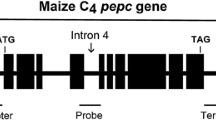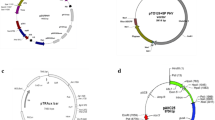Abstract
Trehalose is a non-reducing disaccharide of glucose that occurs in a large number of organisms, playing an important role in desiccation and heat stress protection. Trehalose accumulation has proven to be an effective way of increasing drought tolerance in both model plants such as tobacco and important crops such as potato or rice. In this work we aim to genetically engineer maize with the Arabidopsis thaliana trehalose phosphate synthase gene (AtTPS1), involved in trehalose biosynthesis via electroporation. A cassette harboring the AtTPS1 gene under the control of the CaMV35S promoter and the Bialaphos resistance gene Bar as a selective agent was inserted in the plasmid vector pGreen0229 and used to transform maize inbred line Pa91 via electroporation. Fifteen putative transgenic plants (T0 generation) were obtained. Transgene integration in T0 plants was analyzed by Southern-blot analysis. T0 plants had normal phenotypes, although smaller than wild type plants. Contrary to wild type plants, when sexual organs emerged, tassels appeared at least 15 days earlier than ears in the same plant, rendering impossible the self-pollination of the T0 plant. These plants were then crossed with wild type plants and in some cases T1 seeds were obtained. T1 seeds presented deformities, especially the lack of endosperm, but it was still possible to germinate some of these seeds. The so obtained plants were tested by Northern blot but no AtTPS1 gene expression was detected, a fact possibly due to the incomplete insertion of the AtTPS1 gene or an extremely low gene expression level.







Similar content being viewed by others
References
Almeida AM, Villalobos E, Araújo SS, Leyman B, van Dijk P, Alfaro-Cardoso L, Fevereiro PS, Torné JM, Santos DM (2005) Transformation of tobacco with an Arabidopsis thaliana gene involved in trehalose biosynthesis increases tolerance to several abiotic stresses. Euphytica 146:165–176
Amasino A (1986) Acceleration of nucleic acid hybridization rate by polyethyleneglycol. Ann Biochem 152:304–307
Bohorova N, Zhang W, Julstrum P, McLean S, Luna B, Brito RM, Diaz L, Ramos ME, Estanol P, Pacheco M, Salgado M, Hoisington D (1999) Production of transgenic tropical maize with cryIAb and cryIAc genes via microprojectile bombardment of immature embryos. Theor Appl Genet 99:437–444
Chu CC, Wang CC, Sun CS, Hsu C, Yin KC, Chu CY, Bi FY (1975) Establishment of an efficient medium for anther culture of rice through comparative experiments on the nitrogen sources. Sci Sin B 18:659–665
Dellaporta S, Wood J, Hicks J (1983) A plant DNA minipreparation: version II. Plant Mol Biol Rep 1:19–21
D’Halluin K, Bonne E, Bossut M, Beuckler MD, Leemans J (1992) Transgenic maize plants by tissue electroporation. Plant Cell 4:1495–1505
D’Halluin K, Bonne E, Bossut M, le Page R (1994) Transformation of maize via tissue electroporation. Methods Mol Biol 111:367–373
D’Halluin K, de Block M, Denecke J, Janssens J, Leemans J, Reymaerts A, Botterman J (1995) The bar gene as selectable and screenable marker in plant engineering. Recombinant DNA methodology II. Academic, New York, pp 157–168
Elbein AD (1974) The metabolism of α,α-trehalose. Adv Carbohydr Chem Biochem 30:227–256
Frame B, Shou H, Chikwamba RK, Zhang Z, Xinag CZ, Fonger TM, Pegg SE, Li B, Nettleton DS, Pei D, Wan K (2002) Agrobacterium tumefaciens mediated transformation of maize embryos using a standard binary vector system. Plant Physiol 129:13–22
Garg AK, Kim JK, Ranwala AP, Choi YD, Kochian LV, Wu RJ (2002) Trehalose accumulation in rice plants confers high tolerance levels to different abiotic stresses. Proc Nat Acad Sci 9925:15898–15803
Goddijn OJ, van Dun K (1999) Trehalose metabolism in plants. Trends Plant Sci 48:315–319
Goddijn OJ, Verwoerd TC, Voogd E, Krutwagen RW, de Graaf PT, Poels J, van Dun K, Ponstein AS, Damm B, Pen J (1997) Inhibition of trehalase activity enhances trehalose accumulation in transgenic plants. Plant Physiol 113:181–190
Gould J, Devey M, Hasegawa O, Ullian EC, Peterson G, Smith RH (1991) Transformation of Zea mays L. using Agrobacterium tumefaciens and the shoot apex. Plant Physiol 95:426–434
Hellens RP, Edwards EA, Leyland NR, Bean S, Mullineaux PM (2000) pGreen: a versatile and flexible binary Ti vector for Agrobacterium-mediated plant transformation. Plant Mol Biol 42:819–832
Ishida Y, Saito H, Ohta S, Hiei Y, Komari T, Kumashiro T (1996) High efficient transformation of maize Zea mays L. mediated by Agrobacterium tumefaciens. Nat Biotechnol 14:745–750
Iturriaga G, Gaff DF, Zentella R (2000) New desiccation tolerant plants, including a grass in the central highlands of Mexico, accumulate trehalose. Aust J Bot 48:153–158
Jang IC, Oh S, Seo JS, Choi WB, Song SY, Kim CH, Kim YS, Seo HS, Choi YD, Nahm BH, Kim JK (2003) Expression of a bifunctional fusion of the Escherichia coli genes for trehalose-6-phosphate synthase and trehalose-6-phosphate phosphatase in transgenic rice plants increases trehalose accumulation and abiotic stress tolerance without stunting growth. Plant Physiol 131:516–524
Komari T, Hiei Y, Ishida T, Kumashiro T, Kubo Y (1998) Advances in cereal gene transfer. Curr Opin Plant Biol 1:161–165
Murashige T, Skoog F (1962) A revised medium for rapid growth and bioassays with tobacco tissue cultures. Physiol Plant 15:473–497
Romero C, Belés JM, Vayá JL, Serrano R, Culiañez-Maciá FA (1997) Expression of the yeast trehalose-6-phosphate synthase gene in transgenic tobacco plants: pleiotropic phenotypes include drought tolerance. Planta 201:293–297
Sambrook J, Fritsch EF, Maniatis T (1989) Molecular cloning: a laboratory manual, 2nd edn. Cold Spring Harbour, New York
Satoh-Nagasawa N, Nagasawa N, Malcomber S, Sakai H, Jackson D (2006) A trehalose metabolic enzyme controls inflorescence architecture in maize. Nature 441:227–230
Scott P (1999) Resurrection plants and the secrets of eternal leaf. Ann Bot 85:159–166
Siedow JN (2001) Feeding ten billion people, three views. Plant Physiol 126:20–22
Thompson JA, Drayton RR, Frame BR, Wang K, Dunwell J (1995) Maize transformation utilizing silicon carbide whiskers: a review. Euphytica 85:75–80
Wang K, Drayton P, Frame B, Dunwel J, Thompson J (1995) Whisker mediated plant transformation: an alternative technology. In Vitro Cell Dev Biol 31:101–104
Wingler A (2002) The function of trehalose biosynthesis in plants. Phytochemistry 60:437–440
Yeo ET, Kwon HB, Han SE, Lee JT, Ryu JC, Byun MO (2000) Genetic engineering of drought resistant potato plants by introduction of the trehalose-6-phosphate synthase TPS1 gene from Saccharomyces cerevisae. Mol Cells 10:263–268
Zhong H, Sun B, Warkentin D, Zhang S, Wu R, Wu T, Sticklen MB (1996) The competence of maize shoots meristems for integrated transformation and inherited expression of transgenes. Plant Physiol 110:1097–1107
Acknowledgments
Authors acknowledge financial support from Fundação para Ciência e a Tecnologia (PRAXISXXI/BD/21270/99 A.M. Almeida), H. Schleppmann (Utrech University, Utrech, The Netherlands) and P. Mullineaux (John Innes, Norwich, England) for supplying, respectively, the AtTPS1 gene and the pGreen 0229 plasmid, as well as contributions from S. Duque, J. Paiva and A. Campos, the greenhouse work of P. Fontanet and A. Sanz and photography work of A. Sanchez.
Author information
Authors and Affiliations
Corresponding author
Additional information
Communicated by J. Sadowski.
Rights and permissions
About this article
Cite this article
Almeida, A.M., Villalobos, E., Araújo, S.S. et al. Electroporation of maize embryogenic calli with the trehalose-6-phosphate synthase gene from Arabidopsis thaliana . Acta Physiol Plant 29, 273–281 (2007). https://doi.org/10.1007/s11738-007-0034-5
Received:
Revised:
Accepted:
Published:
Issue Date:
DOI: https://doi.org/10.1007/s11738-007-0034-5




